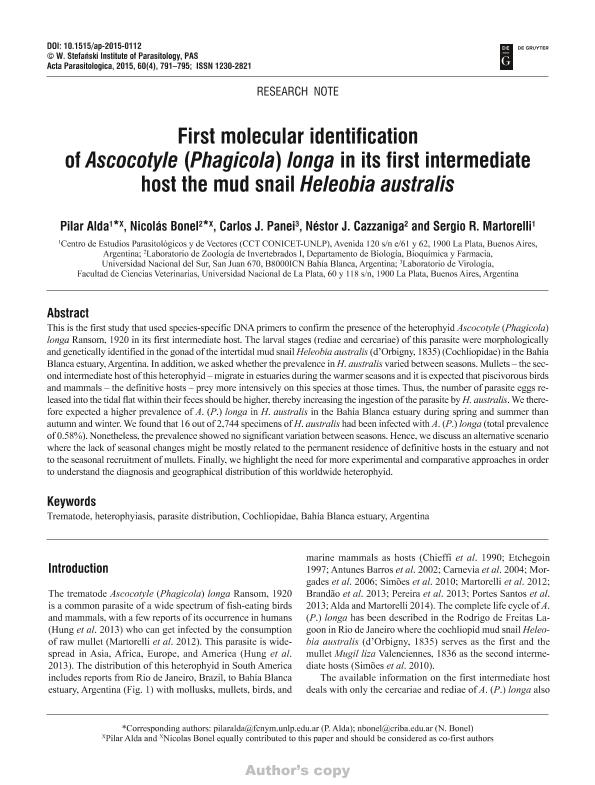Mostrar el registro sencillo del ítem
dc.contributor.author
Alda, Maria del Pilar

dc.contributor.author
Bonel, Nicolás

dc.contributor.author
Panei, Carlos Javier

dc.contributor.author
Cazzaniga, Néstor J.
dc.contributor.author
Martorelli, Sergio Roberto

dc.date.available
2016-12-19T20:44:30Z
dc.date.issued
2015-12
dc.identifier.citation
Alda, Maria del Pilar; Bonel, Nicolás; Panei, Carlos Javier; Cazzaniga, Néstor J.; Martorelli, Sergio Roberto; First molecular identification of Ascocotyle (Phagicola) longa in its first intermediate host the mud snail Heleobia australis; De Gruyter; Acta Parasitologica; 60; 4; 12-2015; 791-795
dc.identifier.issn
1230-2821
dc.identifier.uri
http://hdl.handle.net/11336/9789
dc.description.abstract
This is the first study that used species-specific DNA primers to confirm the presence of the heterophyid Ascocotyle (Phagicola) longa Ransom, 1920 in its first intermediate host. The larval stages (rediae and cercariae) of this parasite were morphologically and genetically identified in the gonad of the intertidal mud snail Heleobia australis(d’Orbigny, 1835) (Cochliopidae) in the Bahía Blanca estuary, Argentina. In addition, we asked whether the prevalence in H. australis varied between seasons. Mullets – the second intermediate host of this heterophyid – migrate in estuaries during the warmer seasons and it is expected that piscivorous birds and mammals – the definitive hosts – prey more intensively on this species at those times. Thus, the number of parasite eggs released into the tidal flat within their feces should be higher, thereby increasing the ingestion of the parasite by H. australis. We therefore expected a higher prevalence of A. (P.) longa in H. australis in the Bahía Blanca estuary during spring and summer than autumn and winter. We found that 16 out of 2,744 specimens of H. australis had been infected with A. (P.) longa (total prevalence of 0.58%). Nonetheless, the prevalence showed no significant variation between seasons. Hence, we discuss an alternative scenario where the lack of seasonal changes might be mostly related to the permanent residence of definitive hosts in the estuary and not to the seasonal recruitment of mullets. Finally, we highlight the need for more experimental and comparative approaches in order to understand the diagnosis and geographical distribution of this worldwide heterophyid.
dc.format
application/pdf
dc.language.iso
eng
dc.publisher
De Gruyter
dc.rights
info:eu-repo/semantics/openAccess
dc.rights.uri
https://creativecommons.org/licenses/by-nc-sa/2.5/ar/
dc.subject
Trematode
dc.subject
Heterophyiasis
dc.subject
Parasite Distribution
dc.subject
Cochliopidae
dc.subject
Bahía Blanca Estuary
dc.subject
Argentina
dc.subject.classification
Otras Ciencias Biológicas

dc.subject.classification
Ciencias Biológicas

dc.subject.classification
CIENCIAS NATURALES Y EXACTAS

dc.title
First molecular identification of Ascocotyle (Phagicola) longa in its first intermediate host the mud snail Heleobia australis
dc.type
info:eu-repo/semantics/article
dc.type
info:ar-repo/semantics/artículo
dc.type
info:eu-repo/semantics/publishedVersion
dc.date.updated
2016-12-12T14:33:04Z
dc.identifier.eissn
1896-1851
dc.journal.volume
60
dc.journal.number
4
dc.journal.pagination
791-795
dc.journal.pais
Alemania

dc.journal.ciudad
Berlin
dc.description.fil
Fil: Alda, Maria del Pilar. Consejo Nacional de Investigaciones Científicas y Técnicas. Centro Científico Tecnológico la Plata. Centro de Estudios Parasitológicos y de Vectores (i); Argentina
dc.description.fil
Fil: Bonel, Nicolás. Universidad Nacional del Sur. Departamento de Biologia, Bioquimica y Farmacia. Laboratorio de Zoologia de Invertebrados I; Argentina
dc.description.fil
Fil: Panei, Carlos Javier. Universidad Nacional de La Plata. Facultad de Ciencias Veterinarias. Laboratorio de Virología; Argentina
dc.description.fil
Fil: Cazzaniga, Néstor J.. Universidad Nacional del Sur. Departamento de Biologia, Bioquimica y Farmacia. Laboratorio de Zoologia de Invertebrados I; Argentina
dc.description.fil
Fil: Martorelli, Sergio Roberto. Consejo Nacional de Investigaciones Científicas y Técnicas. Centro Científico Tecnológico la Plata. Centro de Estudios Parasitológicos y de Vectores (i); Argentina
dc.journal.title
Acta Parasitologica

dc.relation.alternativeid
info:eu-repo/semantics/altIdentifier/url/http://www.degruyter.com/view/j/ap.2015.60.issue-4/ap-2015-0112/ap-2015-0112.xml
dc.relation.alternativeid
info:eu-repo/semantics/altIdentifier/doi/http://dx.doi.org/10.1515/ap-2015-0112
Archivos asociados
